Varied styles at RHS Chelsea Space to Grow
 Here is our quickie overview of the Space to Grow gardens at this year’s (2018) RHS Chelsea Flower Show. This is a new category this year and I am sure that it will be a big hit with show visitors. Each Space to Grow garden varies in style and planting, they are urban spaces that all deliver a message through their design and horticulture. We thought they were a brilliant addition to the show and hope they will be returning next year. Lots to take away from them for the urban gardener too.
Here is our quickie overview of the Space to Grow gardens at this year’s (2018) RHS Chelsea Flower Show. This is a new category this year and I am sure that it will be a big hit with show visitors. Each Space to Grow garden varies in style and planting, they are urban spaces that all deliver a message through their design and horticulture. We thought they were a brilliant addition to the show and hope they will be returning next year. Lots to take away from them for the urban gardener too.
First off the lovely Seedlip Garden designed by Dr Catherine MacDonald (Gold) celebrating the humble pea – pictured page banner above – a really lovely garden with colours and multi-sensory elements all relevant to the pea. Loved the garden path, formed of circular elements, representing the form of the pea.
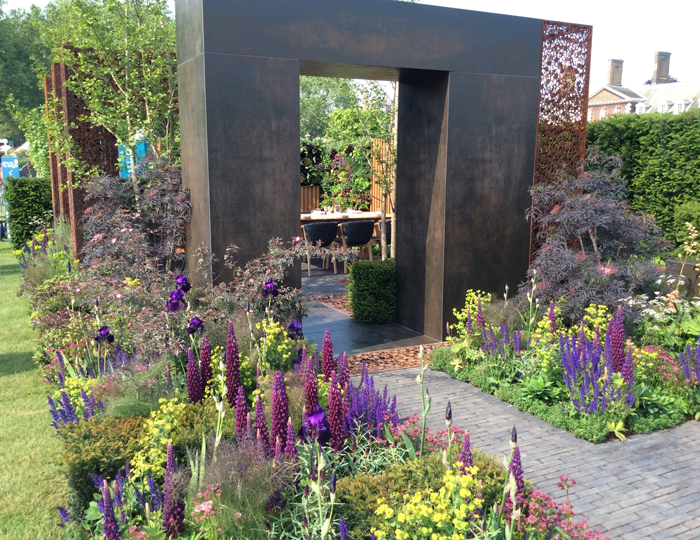 The Urban Flow Garden designed by Tony Woods for Thames Water (Gold and Best in Category) has lots of important messages and ideas for the urban gardener with water conservation in mind. Practical and colourful planting soften the design with plants chosen to tolerate a range of unpredictable climate conditions. Garden materials include traditional hand-crafted clay bricks, porcelain cladding and corten steel. (above)
The Urban Flow Garden designed by Tony Woods for Thames Water (Gold and Best in Category) has lots of important messages and ideas for the urban gardener with water conservation in mind. Practical and colourful planting soften the design with plants chosen to tolerate a range of unpredictable climate conditions. Garden materials include traditional hand-crafted clay bricks, porcelain cladding and corten steel. (above)
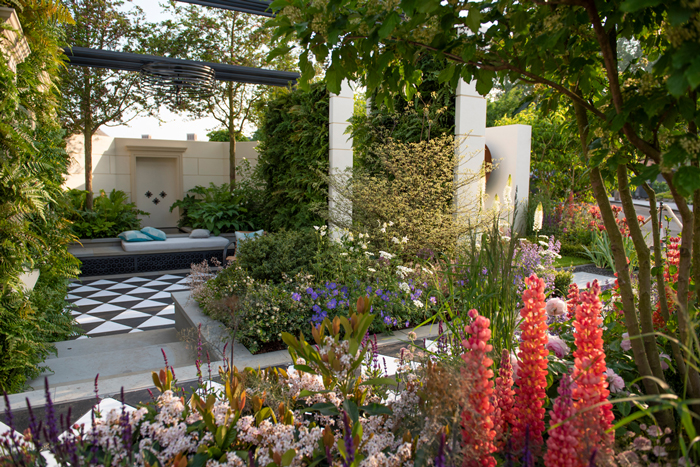 The New West End Garden (Gold) designed by Kate Gould is simply stunning. One of my favourites in this category, it is a modern interpretation of the gardens and architecture of a London Square. It utilises environmentally positive technology, including energy harvesting systems for residents and visitors and the whole design certainly invites you to enter the garden, linger and enjoy. Really brilliant design and very practical. (above)
The New West End Garden (Gold) designed by Kate Gould is simply stunning. One of my favourites in this category, it is a modern interpretation of the gardens and architecture of a London Square. It utilises environmentally positive technology, including energy harvesting systems for residents and visitors and the whole design certainly invites you to enter the garden, linger and enjoy. Really brilliant design and very practical. (above)
The Pearlfisher Garden, in partnership with Plastic Oceans, is fascinating. The garden consists of a series of below-water aquatic tanks filled with specimen planting including cacti, succulents and exotics. It provides a window to the world of our unseen treasures at the same time as highlighting and cautioning the irrevocable impact of plastic waste.
As the team point out, 78 million tons of plastic packaging is produced annually, 32% of which is flowing into our oceans. This garden is a call to action to reduce the amount of plastic packaging we use.
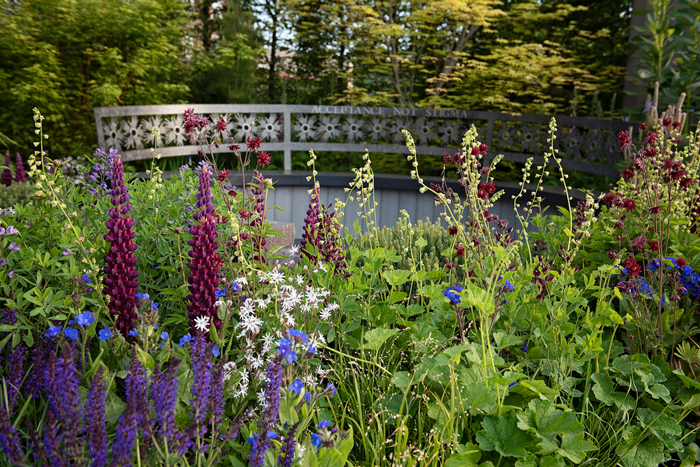 The CHERUB HIV Garden: A Life Without Walls (Silver-Gilt) designed by Naomi Ferrett-Cohen, depicts the journey a young person faces living with HIV. The path weaving through the garden from a white pod represents a move to a life of more freedom as well as the obstacles encountered. Naomi uses over 1,000 plants with key species including Acer Osakazuki, Acer Vitifolium and Dicksonia antartica. (above)
The CHERUB HIV Garden: A Life Without Walls (Silver-Gilt) designed by Naomi Ferrett-Cohen, depicts the journey a young person faces living with HIV. The path weaving through the garden from a white pod represents a move to a life of more freedom as well as the obstacles encountered. Naomi uses over 1,000 plants with key species including Acer Osakazuki, Acer Vitifolium and Dicksonia antartica. (above)
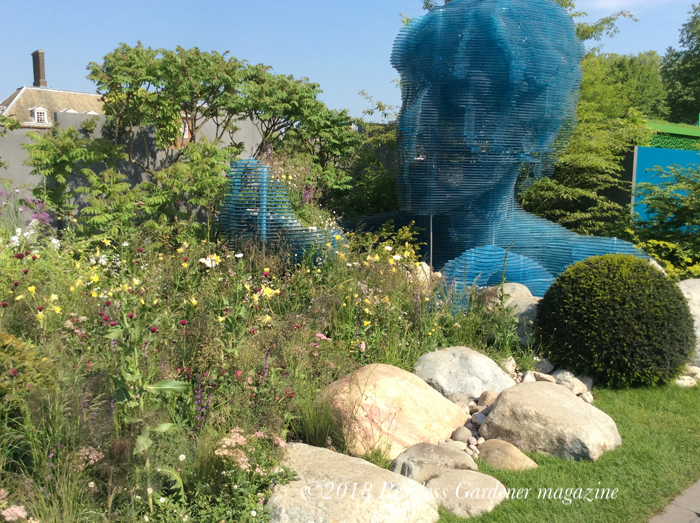 The striking giant sculpture on The Myeloma Garden (Silver-Gilt) designed by John Everiss and Francesca Murrell, certainly makes a statement. It is constructed from layers of Arctic blue acrylic and represents the role of the carer, who is often crucial in ensuring the patient remains the main focus of a myeloma diagnosis. Boulders represent plasma cells and the sculpture is blowing seeds and plants onto fertile soil representing new treatment and a sign of hope and growth. (above)
The striking giant sculpture on The Myeloma Garden (Silver-Gilt) designed by John Everiss and Francesca Murrell, certainly makes a statement. It is constructed from layers of Arctic blue acrylic and represents the role of the carer, who is often crucial in ensuring the patient remains the main focus of a myeloma diagnosis. Boulders represent plasma cells and the sculpture is blowing seeds and plants onto fertile soil representing new treatment and a sign of hope and growth. (above)
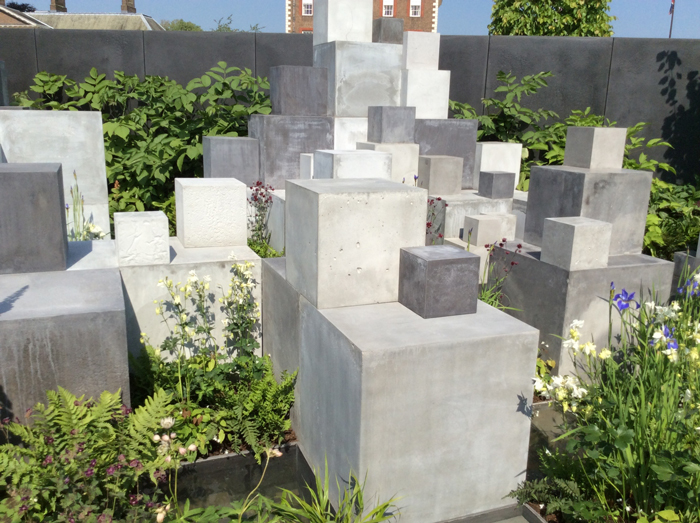 Chelsea is certainly a show of contrasting surfaces this year and the above garden, Skin Deep, designed by Robert Barker (Silver-Gilt) uses concrete blocks to represent people with varying skin conditions, softened by planting. The texture of the various plants against the blocks softens the hard surface and also highlights the shades and form of the planting.
Chelsea is certainly a show of contrasting surfaces this year and the above garden, Skin Deep, designed by Robert Barker (Silver-Gilt) uses concrete blocks to represent people with varying skin conditions, softened by planting. The texture of the various plants against the blocks softens the hard surface and also highlights the shades and form of the planting.
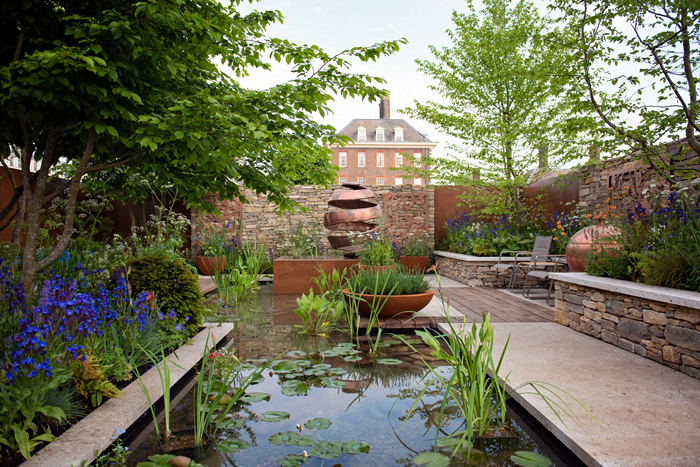 The Silent Pool Gin Garden (Silver-Gilt) designed by David Neale, provides a contemporary and relaxing city haven for a professional couple. The materials used in the garden are influenced by the distiller’s careful selection and the beautiful Portland stone and Purbeck walling used on the garden certainly adds a charm and grace to the whole design. I particularly liked the copper panels and central ‘citrus peel’ sculpture, a nod to the gin making process itself. (above)
The Silent Pool Gin Garden (Silver-Gilt) designed by David Neale, provides a contemporary and relaxing city haven for a professional couple. The materials used in the garden are influenced by the distiller’s careful selection and the beautiful Portland stone and Purbeck walling used on the garden certainly adds a charm and grace to the whole design. I particularly liked the copper panels and central ‘citrus peel’ sculpture, a nod to the gin making process itself. (above)
All eight gardens have very distinctive identities and I particularly liked the fact they were situated side-by-side so no chance of missing one as you walk around.
Photo credits: All photographs ©EmmaJCampbell Photography/Reckless Gardener.

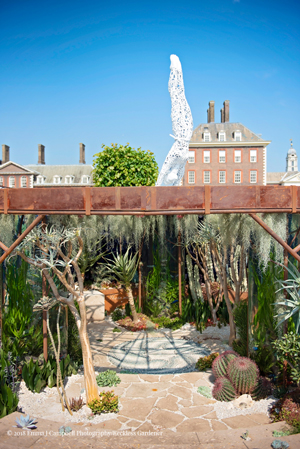 The Pearlfisher Garden (Gold) pictured left, designed by John Warland and the Pearlfisher team, is one of the most amazing gardens at this year’s RHS Chelsea. Celebrating the beauty of the vast underwater garden in our great oceans, it highlights the damage being done to our environment and particularly our oceans, by plastic.
The Pearlfisher Garden (Gold) pictured left, designed by John Warland and the Pearlfisher team, is one of the most amazing gardens at this year’s RHS Chelsea. Celebrating the beauty of the vast underwater garden in our great oceans, it highlights the damage being done to our environment and particularly our oceans, by plastic. 